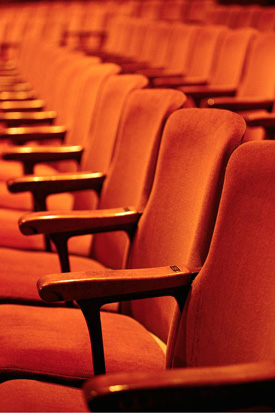Experience Design Theatre: Just an act?
The paper I chose this week was “Experience Design Theatre: Exploring the Role of Live Theatre in Scaffolding Design Dialogues”. In this paper, Vines et al explore the use of interactive theatre as a novel participatory design technique and critically compared it to other similar techniques, such as role-play and short film production. This was the reason I chose the paper over the others available – I know relatively little about specific participatory design techniques and would never have considered design theatre before reading it.
The paper puts forwards Experience Design Theatre (EDT) as a way of exploring future scenarios, using professional actors to play out scenarios and adapt to participants’ interactions and suggestions. The paper’s study regarding a volunteer carer service used EDT over five separate phases, using different participant ‘audiences’ in each and using their feedback and suggestions to alter the performance at each stage. As a result, EDT is an unusual form of a prototyping workshop, with the imaginary end product (the volunteer service, in this case) evolving according to feedback and criticism.
 Participants were encouraged to provide feedback during the performance, meaning that it could be immediately adapted according to the participants’ suggestions and re-enacted. This “re-direction” of scenes provided immediate feedback for the participants, which is something that many other types of workshop might lack. For example: a designer may take notes during a more traditional workshop session, but it’s possible that the participant would not see any changes to the prototype until the next one, if at all. With EDT the participants are immediately shown that not only are they being listened to, but their feedback is being used to directly alter the design. Knowing that their feedback is actually being put into effect could make participants more likely to actively participate.
Participants were encouraged to provide feedback during the performance, meaning that it could be immediately adapted according to the participants’ suggestions and re-enacted. This “re-direction” of scenes provided immediate feedback for the participants, which is something that many other types of workshop might lack. For example: a designer may take notes during a more traditional workshop session, but it’s possible that the participant would not see any changes to the prototype until the next one, if at all. With EDT the participants are immediately shown that not only are they being listened to, but their feedback is being used to directly alter the design. Knowing that their feedback is actually being put into effect could make participants more likely to actively participate.
Because the structure of the performances and interactions with the participants was necessarily loose due to the improvisational nature of them, the performance could be adapted to accommodate unforeseen requirements. For example, it was unexpected how much the participants in the study valued the impromptu questioning of the actors (both in and out of character). To facilitate this, the performance was adapted to allow for ‘hot seating’ of characters after scenes played out.
One of the other main strengths of EDT proved to be the emotional connections that the participants grew to have with the performance’s characters. The nature of theatre required that the characters’ emotions and drivers had to be constructed – elements which may not have been considered as fully through other exploratory techniques. These emotional connections allowed for participants to see viewpoints that had otherwise not been considered – one participant noted “I can now see where its value may lie”.
Not all that was presented in the paper was positive, however: EDT was found to have a couple of downsides. The most obvious being the cost involved with setting up this number of sessions with professional actors, who obviously have to be compensated for their time. A larger space would also be necessary, which may be an issue for researchers who don’t have immediate access to one.
A larger issue came to the forefront when a participant was disappointed that their feedback hadn’t been acted upon in the following performance. The participant felt that “solutions were discussed” and hadn’t been fully acted upon, resulting in disappointment. The authors also note that one of EDT’s main weaknesses is that it can trivialise participant expertise and knowledge – one participant had expected that the actors and researchers be experts about the topic and was disappointed with the “simplistic portrayal of care”.
From this paper, it seems like experience design theatre is an extremely useful tool for exploring future designs and prototypes as it allows for participants to be immediately gratified for their input. However, researchers need to be careful to be careful when taking participants’ feedback on board, as misinterpreting or not including it could result in the participants being disenchanted with the whole process.
Leave a Reply Cancel reply
You must be logged in to post a comment.